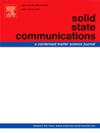硼苯片作为检测和去除有害气体分子的潜在候选者
IF 2.1
4区 物理与天体物理
Q3 PHYSICS, CONDENSED MATTER
引用次数: 0
摘要
石墨烯的合成标志着二维材料新时代的开始,二维材料以其卓越的性能和广泛的应用而闻名。在新兴的单元素Xenes家族中,硼苯——完全由硼原子组成——由于其奇异的键态而脱颖而出,从而产生了多种多晶型和广泛的应用。本研究重点研究了三种不同的硼罗芬结构:弯曲六方结构、α-片状结构和蜂窝状结构,每种结构都具有独特的硼密度。它们检测和捕获五种有害气体分子(CO, CO2, NO, NO2和NH3)的潜力被彻底评估。这项工作的新颖之处在于分析了这些气体与众所周知的α-片状和蜂窝状硼罗芬之间的相互作用,同时以弯曲形式作为参考。结果表明,硼罗芬在有害气体传感和去除方面具有重要的应用前景。本文章由计算机程序翻译,如有差异,请以英文原文为准。

Borophene sheets as potential candidates for the detection and removal of harmful gas molecules
The synthesis of graphene marked the beginning of a new era for two-dimensional materials, celebrated for their exceptional properties and wide-ranging applications. Among the emerging mono-elemental Xenes family, borophene – composed entirely of boron atoms – stands out due to its exotic bonding states, which give rise to diverse polymorphs and versatile applications. This study focuses on three distinct borophene structures: the buckled hexagonal, the -sheet, and the honeycomb-like forms, each characterized by unique boron densities. Their potential for detecting and capturing five harmful gas molecules (CO, CO, NO, NO, and NH) is thoroughly assessed. The novelty of this work lies in analyzing the interactions between these gases and the well-known -sheet and honeycomb-like borophene, while using the buckled form as a reference. The results indicate that borophene holds significant promise for applications in hazardous gas sensing and removal.
求助全文
通过发布文献求助,成功后即可免费获取论文全文。
去求助
来源期刊

Solid State Communications
物理-物理:凝聚态物理
CiteScore
3.40
自引率
4.80%
发文量
287
审稿时长
51 days
期刊介绍:
Solid State Communications is an international medium for the publication of short communications and original research articles on significant developments in condensed matter science, giving scientists immediate access to important, recently completed work. The journal publishes original experimental and theoretical research on the physical and chemical properties of solids and other condensed systems and also on their preparation. The submission of manuscripts reporting research on the basic physics of materials science and devices, as well as of state-of-the-art microstructures and nanostructures, is encouraged.
A coherent quantitative treatment emphasizing new physics is expected rather than a simple accumulation of experimental data. Consistent with these aims, the short communications should be kept concise and short, usually not longer than six printed pages. The number of figures and tables should also be kept to a minimum. Solid State Communications now also welcomes original research articles without length restrictions.
The Fast-Track section of Solid State Communications is the venue for very rapid publication of short communications on significant developments in condensed matter science. The goal is to offer the broad condensed matter community quick and immediate access to publish recently completed papers in research areas that are rapidly evolving and in which there are developments with great potential impact.
 求助内容:
求助内容: 应助结果提醒方式:
应助结果提醒方式:


